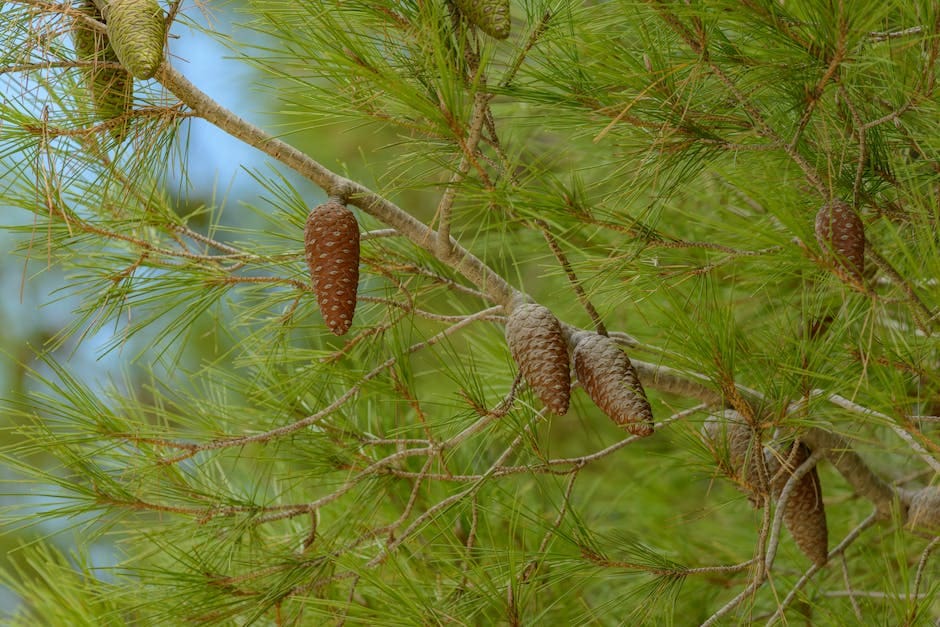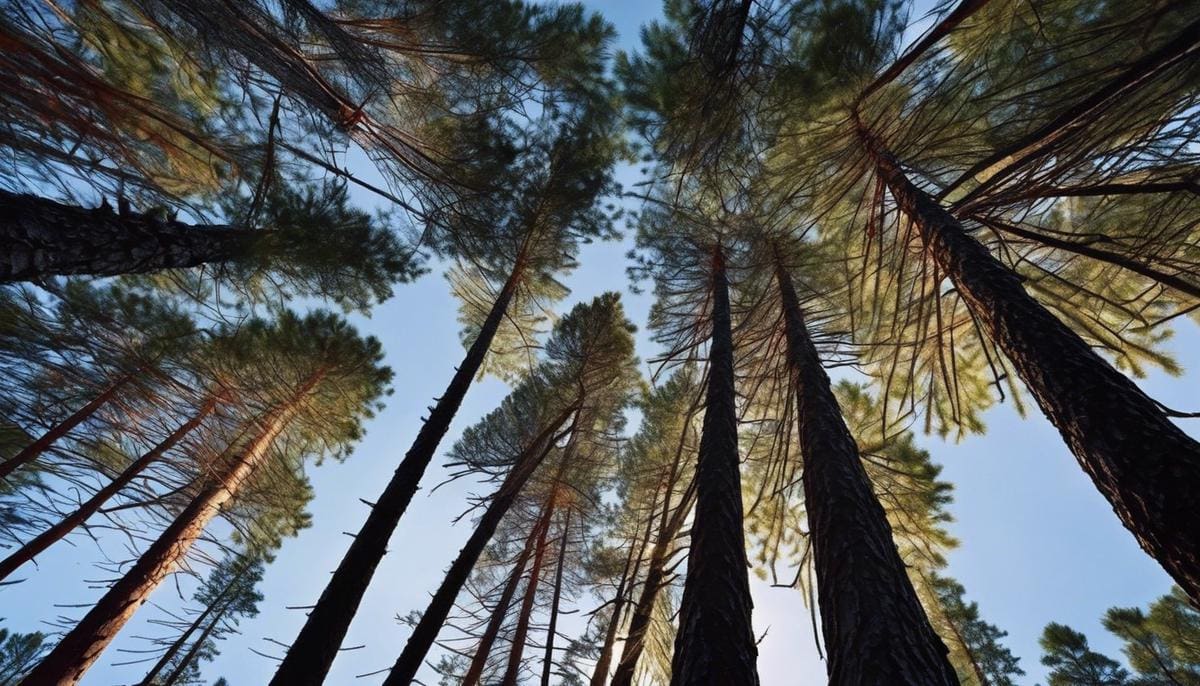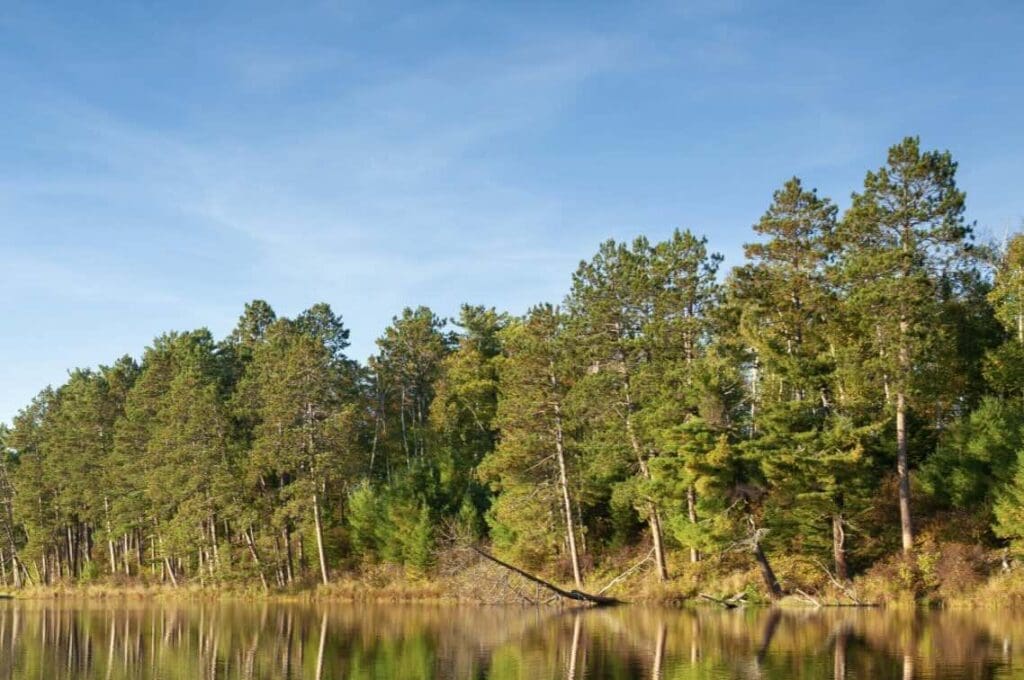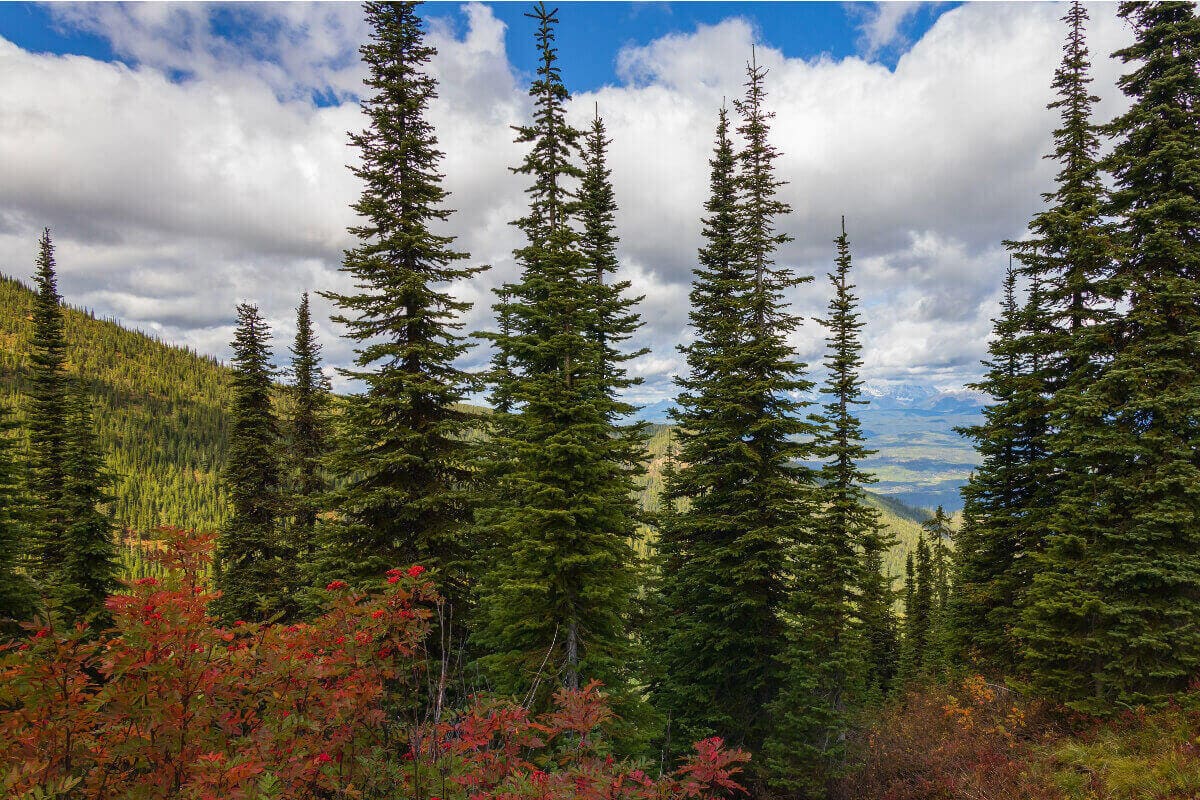Stretching across the vast landscapes of North America, the Jack Pine (Pinus banksiana) stands as a testament to the resilience of boreal forests. These coniferous trees, characterized by their distinct, twisted cones and hardy nature, have carved a niche in the often harsh and fire-scarred terrains they call home. Beyond mere survival, the Jack Pine plays a pivotal role in its ecosystem, thriving in conditions that would stifle less adaptable species.
Through a fascinating blend of morphology and behavior, this species offers a prime example of nature’s unending dance between life and the environment. As we delve into the taxonomy and natural history of the Jack Pine, we uncover the intricacies of a tree that is as enigmatic as it is essential to the health and diversity of boreal forests.
Table of Contents
- Taxonomy and Distribution of Jack Pine
- Reproductive Ecology and Adaptations
- Role in Ecosystems and Biodiversity
- Threats and Conservation Efforts
- Related Content
Taxonomy and Distribution of Jack Pine
Deciphering the Taxonomic Distinctiveness of Jack Pines (Pinus banksiana)
Abstract: The Jack Pine, scientifically termed Pinus banksiana Lamb, is a coniferous member of the Pinaceae family, holding significance in ecological and economic realms. This article elucidates the unique taxonomic characteristics of Jack Pines and outlines their predominantly North American distribution, contributing to a comprehensive understanding necessary for academic study and conservation efforts.
Taxonomic Elucidation of Pinus Banksiana Lamb.
Morphological Distinctions:
- Jack Pines exhibit distinctive physical features that readily facilitate their identification. The leaves, or needles, are fascicled in pairs, with a length of 2-4 cm, often twisted and of a bluish-green hue, distinguishing them from other species within the genus.
- The cones of Pinus banksiana Lamb are particularly singular, asymmetrical, and serotinous, requiring exposure to high heat (often from fire) to release seeds—a vital survival strategy amidst their fire-prone habitats.
- The tree’s bark is irregularly plated and distinctly flaky, providing a haven for many species and a tactile trademark readily utilizable for identification. Jack Pines rarely exceed a height of 22 meters and tend to have a gnarled and irregular growth form. This further cements their ecological niche in addition to a penchant for sparse, sandy soils.
Genetic and Reproductive Signifiers:
- Recent advances in molecular biology enable the differentiation of Jack Pines at the genetic level. DNA markers signify genetic disparity from closely related species, fortifying their standing within the taxonomic framework.
- The serotinous cones confer a competitive reproductive advantage in their natural environs, a signifier intertwined with their evolutionary success.
Geographical Prevalence and Ecosystem Role:
- Jack Pines have a primarily boreal distribution, with a range extending from the Great Lakes region to the interior of Alaska. They are a species emblematic of North America’s vast taiga, thriving in the continental climate characterized by cold winters and temperate summers.
- Pinus banksiana is a pioneer species, often among the first to colonize post-disturbance sites, which underscores their critical role in the succession of forest ecosystems.
Conservation and forestry practices are linked to a robust understanding of Pinus banksiana’s role within its habitat. Its wood is employed in construction and the manufacturing of pulp. At the same time, the ecosystems it anchors are incredibly diverse, hosting species including but not limited to the endangered Kirtland’s Warbler (Setophaga kirtlandii).
In conclusion, the Jack Pine, with its distinctive taxonomic traits and particular habitat preferences, remains an indispensable component of North American forests. Its biological and commercial significance merits continuing academic interest and ecological stewardship to ensure its propagation and sustainability within its indigenous environment.

Reproductive Ecology and Adaptations
The Reproductive Strategies of Jack Pines: Adaptations for Success
In the continuum of coniferous trees, Jack Pines (Pinus banksiana) embodies a paradigm of evolutionary resilience, primarily through their reproductive strategies that ensure propagation and survival in less forgiving habitats. These strategies are multifaceted, optimized, and hinge significantly on the interplay between the species and fire, which is the crux of their life cycle.
Jack Pines have evolved serotinous cones, a unique botanical characteristic wherein the cones remain sealed with a resinous bond. This trait is not an isolated curiosity but a functional adaptation to fire-prone environments.
The cones are designed to open and release seeds primarily in response to the intense heat from wildfires, a phenomenon known as pyriscence. Consequently, post-fire landscapes, rich in resources and offering minimal competition, become ideal nurseries for the germination of Jack Pine seeds.
Additionally, the species exhibits a degree of reproductive versatility through its non-serotinous cones, which disperse seeds independently of fire events. This diversity in reproductive mechanisms underlines an ecological bet-hedging strategy, ensuring that progeny can emerge across various environmental conditions.
The reproductive success of Jack Pines is also tied to its ability to colonize nutrient-poor soils that challenge other plant competitors. Their mycorrhizal relationships, symbiotic partnerships with root fungi, play a crucial role in nutrient acquisition, particularly in the absorption of nitrogen and phosphorus—themself a determinant of reproductive fitness and success.
Jack Pines epitomizes the intricate balance of life in boreal ecosystems through these astute adaptations—serotiny, seed dispersal plasticity, and mycorrhizal symbiosis. Fire ecology plays a significant role in shaping the life cycle of Pinus banksiana, and understanding this dynamic is vital for preserving the intricate tapestry of the forested landscape where these trees proliferate.
In conclusion, Jack Pines leverages a suite of biologically ingenious strategies to mate the vicissitudes of their environment. Such strategies are not merely survival acts but sophisticated adaptations honed over millennia, allowing Jack Pines to thrive in areas where other species may merely subsist.
This deep-seated interconnection with the natural elements that sculpt their habitats underscores the necessity to approach forest management and conservation with a nuanced comprehension of Jack Pines’ reproductive ethos.

Role in Ecosystems and Biodiversity
By their very nature, Jack Pines (Pinus banksiana) is foundational to the structure and efflorescence of boreal ecosystems. Their functional role encompasses abiotic and biotic factors, resulting in many ecological benevolences that ripple through their habitats.
Jack Pines are notable for altering soil composition and structure in abiotic contributions. This species is well-adapted to poor soil conditions that are often acidic and nutrient-poor. Through litterfall and needle decay, these conifers catalyze gradual soil amelioration.
The decomposition of pine needles acidifies the soil, affecting the solubility and availability of vital nutrients. In boreal forests, this process underpins the acid-base dynamics and impacts the overall fertility, thus shaping the assemblage of plant species capable of thriving in such environments.
Beyond soil chemistry, Jack Pines also influences hydrological processes. As a xerophytic species with adaptations to withstand drought, they moderate the local water cycle by transpiration, affecting groundwater recharge and runoff patterns.
The interception of precipitation by pine canopies and subsequent evapotranspiration plays a subtle yet pivotal role in tempering stream flows and maintaining aquifer levels.
Concerning biotic interactions, Jack Pines serve as keystone species for a biodiverse community of flora and fauna. These trees provide nesting habitats and a sturdy perching platform for avian species. For instance, the endangered Kirtland’s Warbler (Setophaga kirtlandii) notably relies on young Jack Pine stands for breeding, nesting in the low branches or at the base of these saplings.
Simultaneously, these pines are integral to intricate food webs. They are not merely passive participants but active constituents that modulate both herbivory dynamics and the presence of higher trophic levels. Various lepidopteran larvae, for example, consume the foliage of Jack Pines and, in turn, become prey for many insectivorous birds and mammals.
Moreover, as providers of the mast in the form of pine seeds, Jack Pines sustain an abundance of wildlife. Their sustenance extends across multiple taxa, ranging from small rodents to birds and invertebrate assemblages that thrive on the litter layer. As a result, these pines are critical in the spatial and temporal sustenance of forest biodiversity.
Jack Pines further contributes to perpetuating genetic diversity within their associated ecosystems. By serving as a genetic reservoir, they amplify the overall resiliency of forests to external stressors such as climate change, pest outbreaks, and anthropogenic influence. This genetic robustness enables adaptability, allowing the ecosystem to maintain functionality in the face of biotic and abiotic shifts.
In conclusion, it is evident that the Jack Pines not only forge their niches within the ecosystems they inhabit but also uphold the complex web of life dependent on them. The numerous ecological services they provide underscore the imperative for their protection and the adoption of rigorous, science-driven forest stewardship.
The intricacies of these ecological narratives remain a testament to the resplendence of Jack Pines and their mysterious bond with the boreal realms in which they flourish.

Threats and Conservation Efforts
Preserving the Jack Pine (Pinus banksiana) is fraught with complex challenges. Primary threats to these coniferous trees can be grouped into biotic and abiotic categories, each impacting survival and propagation.
From an abiotic standpoint, climate change poses a profound threat. Altered precipitation patterns and increased temperatures impact Jack Pine ecosystems detrimentally, as these trees are adapted to more excellent conditions and a specific fire regime.
The progression of climate change may lead to more frequent and severe droughts, weakening trees and making them more susceptible to pests and disease while disrupting the fire cycles necessary for Jack Pine regeneration.
Shifting fire regimes, as a result of both climate change and human interference, jeopardize the species further. Fire suppression efforts have reduced the naturally occurring fires Jack Pines requires to open their serotinous cones and release seeds. Jack Pine regeneration is significantly hampered without these fires, leading to age-class imbalances and fragmented forests.
Biotic threats include invasive pests, such as the Mountain Pine Beetle (Dendroctonus ponderosa), and fungal diseases, like Scleroderris canker (Gremmeniella abietina), which can devastate Jack Pine stands. These organisms can exploit trees weakened by abiotic stressors, resulting in widespread mortality.
Conservation efforts for Jack Pine populations are multifaceted and evolving. Active management techniques, such as prescribed burning, emulate the natural fire regimes necessary to regenerate Jack Pine forests and maintain their biodiversity. Prescribed burns promote the opening of serotinous cones and reduce competition from more fire-intolerant species, thus sustaining Jack Pine’s ecological niche.
Restoration projects focus on replanting Jack Pines in areas where they have been eradicated or are at risk, ensuring that genetic diversity within populations is conserved. Genetic conservation is also being supplemented by ex-situ stratagems, including gene banking and seed collection, which safeguard against catastrophic population losses.
Additionally, increasing awareness and monitoring efforts to detect and control the spread of invasive species are imperative in preserving Jack Pine ecosystems. Integrated pest management strategies that combine biological control agents with selective insecticide use are preferred to mitigate their impact while minimizing ecological disruption.
Last, adaptive management practices that consider the shifting baseline of climate conditions are necessary. These must include developing and implementing climate-smart forestry practices, collaborative research endeavors, and public engagement and education efforts to sustain conservation measures over time.
Conservation efforts for the Jack Pine must be continually updated with research-derived insights, offering these vital but vulnerable trees the best chance of survival in the future. Without such comprehensive and proactive approaches, the resilience of Jack Pine populations and the myriad ecological services they provide could be irreversibly compromised.

The Jack Pine, a sentinel of the North American boreal frontier, provides a lesson in the delicate balance between endurance and vulnerability. Within their needle-clad branches, these trees have withstood the test of time and elements, shaping and nurturing the environment that defines them.
However, as we have seen, their perpetuation is not immune to the ever-growing shadows of environmental threats and human influence. Grasping the full scope of their ecological importance and challenges is crucial for formulating effective conservation strategies.
As guardians of these natural treasures, we must ensure that future generations will witness the resilience and beauty of the Jack Pine, a true icon of wild, unyielding landscapes.
If you are interested in seeing how Mondoro can be a valuable partner for you for wood furniture products – we would love to talk to you to see how we can help you.
Find out more about how Mondoro can help you create, develop, and manufacture excellent home decor and furniture products – don’t hesitate to contact me, Anita. Check out my email by clicking here or become a part of our community and join our newsletter by clicking here.
Mondoro gives out a FREE Lookbook to anyone interested. You can receive a copy of our latest Lookbook by clicking here.
Listen to our Podcast called Global Trade Gal. You can find it on all major podcast platforms. Try out listening to one of our podcasts by clicking here.
Subscribe to our Mondoro Company Limited YouTube Channel filled with great videos and information by clicking here.
Related Content
Difference Between Solid Sheesham Wood, And Teak Wood
Solid Sheesham Wood and Teak Wood are both very different kinds of woods. Even though they are both considered hardwoods, Sheesham wood is softer than teak. Sheesham wood is also considered less durable than teak wood. Many premier manufacturers consider teak wood the ”king of woods.”
You can discover more by reading Difference Between Solid Sheesham Wood, And Teak Wood by clicking here.
Is Teak a Coniferous, Evergreen, or Deciduous Tree? 11 Teak Wood Facts
Teak is a deciduous, not evergreen or coniferous tree. Teak leaves do not fall off in the wintertime, but they fall off in the dry season; in Asia, where teak trees are naturally grown, the dry season is not always the same as winter. As the teak leaves do fall off, the tree is considered to be a deciduous tree.
You can discover more by reading our blog Is Teak a Coniferous, Evergreen, or Deciduous Tree? 11 Teak Wood Facts by clicking here.
What Are The Types Of Wood Used In Furniture?
Wood for furniture is divided up into hard and softwood. Though the woods have some similarities, they also have some differences. Different looks and types of furniture may require a certain kind of wood. Some wood species will be higher priced, and others will be cheaper; price, durability, look, color, finish, and structure can decide what wood to choose for your furniture piece.
You can discover more by reading our blog What Are The Types Of Wood Used In Furniture? by clicking here.

